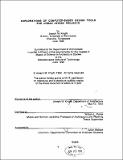Explorations of computer-based design tools for urban design projects
Author(s)
Knight, Joseph M. (Joseph McCarty)
DownloadFull printable version (13.32Mb)
Advisor
William L. Porter.
Terms of use
Metadata
Show full item recordAbstract
This thesis is an investigation into issues involving computers, information, and automation in the designing of large-scale environments. It is an attempt to understand the issues at root in developing an "intelligent" design environment which provides tools for handling tasks often too mundane and distracting for sustained design activity. In the process of devising these tools, fundamental issues regarding the elements or objects of design, their characteristics, and the transformations they undergo are revealed in light of the particular capabilities of the computer. This study was undertaken as an attempt to discover these issues for myself by working to create a system of tools on top of an existing computer-aided design program - a personalized design environment. The path of discovery taken is reconstructed in this paper, in part to illustrate some of the pitfalls of dealing with real-world programming tasks, and also to demonstrate the revelation of the inherent issues that are involved when attempting such a project. Although the programmed end-product is incomplete and greatly simplifies the true nature of such a design problem, the lessons learned are distilled and clarified to provide a basis for further work and investigation in this field. The first part is a synopsis of issues related to computer-aided design: an historic overview, current applications, on-going research and forecasts. This section is provided to illustrate the foundation of understanding that I had when undertaking to develop tools of my own. The second part includes the initial tool concepts and their intended purposes, a discussion of hardware and software platforms, and numerous considerations I was compelled to address while developing modeling and information-handling components of the design environment. Part three deals in depth with a sophisticated tool proposal for instantiating urban type elements for illustrating a possible "realization" of a schematic design; this tool was not able to be developed on the chosen platform. I have also included some possible scenarios for using the modeling and information handling tools.
Description
Thesis (M.S.)--Massachusetts Institute of Technology, Dept. of Architecture, 1992. Includes bibliographical references (leaves 117-118).
Date issued
1992Department
Massachusetts Institute of Technology. Department of ArchitecturePublisher
Massachusetts Institute of Technology
Keywords
Architecture